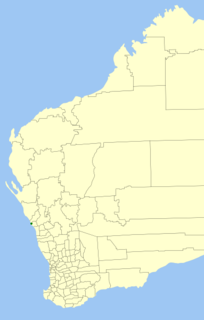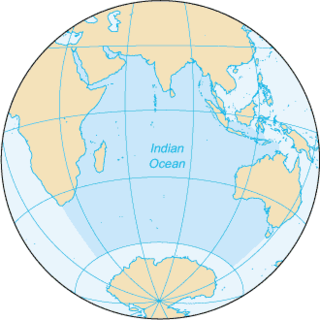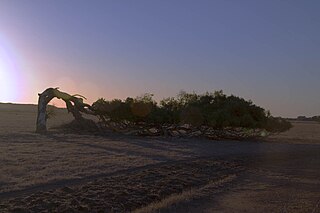
North West Coastal Highway is a generally north-south Western Australian highway which links the coastal city of Geraldton with the town of Port Hedland. The 1,300-kilometre-long (808 mi) road, constructed as a sealed two-lane single carriageway, travels through remote and largely arid landscapes. Carnarvon is the only large settlement on the highway, and is an oasis within the harsh surrounding environment. The entire highway is allocated National Route 1, part of Australia's Highway 1, and parts of the highway are included in tourist routes Batavia Coast Tourist Way and Cossack Tourist Way. Economically, North West Coastal Highway is an important link to the Mid West, Gascoyne and Pilbara regions, supporting the agricultural, pastoral, fishing, and tourism industries, as well as mining and offshore oil and gas production.

The Murchison River is the second longest river in Western Australia. It flows for about 820 km (510 mi) from the southern edge of the Robinson Ranges to the Indian Ocean at Kalbarri. The Murchison-Yalgar-Hope river system is the longest river system in Western Australia. It has a mean annual flow of 208 gigalitres, although in 2006, the peak year on record since 1967, flow was 1,806 gigalitres.

The City of Geraldton was a local government area in the Mid West region of Western Australia, 424 kilometres (263 mi) north of the state capital, Perth on the Indian Ocean. The City covered an area of 46.3 square kilometres (17.9 sq mi), and its seat of government was the town of Geraldton.

The City of Geraldton-Greenough was a local government area in the Mid West region of Western Australia, 424 kilometres (263 mi) north of the state capital, Perth on the Indian Ocean. It covered an area of 1,798.3 square kilometres (694.3 sq mi), and its seat of government was the town of Geraldton.

Hill River is a river in the Wheatbelt region of Western Australia.

Cape Burney is a coastal town and locality 12 kilometres (7 mi) south of Geraldton, Western Australia at the mouth of the Greenough River. Its local government area is the City of Greater Geraldton. At the 2006 census, Cape Burney had a population of 399.
Glenfield is a locality north of Geraldton, Western Australia. Its local government area is the City of Greater Geraldton.

Chapman River is a river in the Mid West region of Western Australia.

The Irwin River is a river in the Mid West of Western Australia. It was named on 9 April 1839 by the explorer George Grey, while on his second disastrous exploration expedition along the Western Australian coast, after his friend Major Frederick Irwin, the Commandant of the Swan River settlement, and later acting Governor of Western Australia from 1847 to 1848.
Hutt River is a river in the Mid West region of Western Australia.
The Preston River is a river in the South West region of Western Australia.

Hutt Lagoon is a salt lake located near the coast just north of the mouth of the Hutt River, in the Mid West region of Western Australia.
The Bowes River is a river in the Mid West of Western Australia. It was named on 6 April 1839 by the explorer George Grey while on his second exploration expedition along the Western Australian coast. It was named for Mary Bowes, Dowager Countess of Strathmore, the wife of Sir William Hutt. Hutt was a British Liberal politician who was heavily involved in the colonization of New Zealand and South Australia, and the brother of John Hutt, the second governor of Western Australia. Sir William Hutt was a member of the 1836 select committee on Disposal of Lands in the British Colonies. Grey named the nearby Hutt River after Hutt.
The Yule River is an ephemeral river in the Pilbara region of Western Australia. It was named on 10 August 1861 by the surveyor and explorer Frank Gregory while on expedition in the area, after Thomas Newte Yule, at times farmer of Toodyay, winemaker, Acting Colonial Secretary and Magistrate.
The Nambung River is a river in the Wheatbelt region of Western Australia, 170 kilometres (106 mi) north of Perth. The river drains an area between the towns of Cervantes and Badgingarra. In its lower reaches the Nambung River forms a chain of waterholes in the Nambung Wetlands where it disappears underground into a limestone karst system 5.5 kilometres (3 mi) from the Indian Ocean.

The City of Greater Geraldton is a local government area in the Mid West region of Western Australia, 424 kilometres (263 mi) north of the state capital, Perth on the Indian Ocean. It covers an area of 12,625.5 square kilometres (4,874.7 sq mi), and its seat of government is the town of Geraldton.
The Buller River is a river in the Mid West of Western Australia, near Geraldton.
The Greenough River Solar Farm is a 10 megawatt (MW) photovoltaic power station located in Walkaway, Western Australia. When it opened in October, 2012, it was the country's first utility-scale solar farm. It remained Australia's largest solar PV system until 2014, when it was superseded by the 20 MW Royalla solar farm in Canberra. The Greenough River Solar Farm was built by Verve Energy and joint venture partners GE Financial Services. It uses over 150,000 thin film modules based on CdTe-PV technology provided by U.S. company First Solar. Its exact location is at Nangetty Walkaway Road, Walkaway, 50 kilometres southeast of Geraldton and covers an area of 80 hectares.















